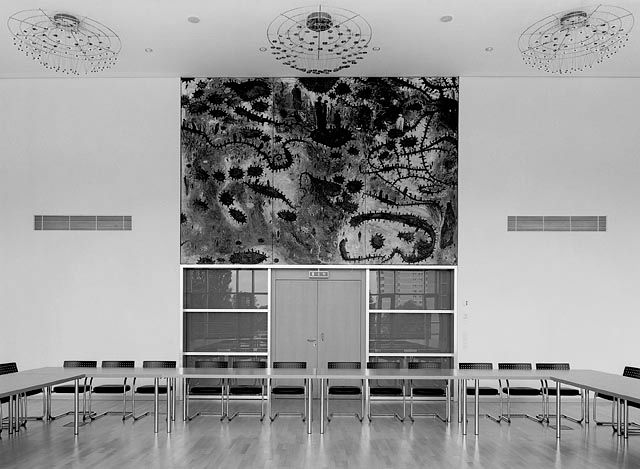Gunter Damisch
:
Installation in the Government District
Back
Information
The two-stage competition provided the background to the artistic intervention in St. Pölten, for which seven artworks by Austrian artists were recommended for realisation. These projects are by Josef Danner, Bruno Gironcoli, Richard Hoeck, Hans Kupelwieser, Christoph Steffner, Thomas Stimm and Heimo Zobernig. Five commissions for interiors were awarded directly, to Gunter Damisch, Franz Graf, Brigitte Kowanz, Eva Schlegel and Walter Vopava. The winning project in a separate competition for the design of the chapel (1995) is by Arnulf Rainer. Additional existing artworks by Franz Xaver Ölzant, Oskar Putz and Ruth Schnell are also to be found in the Regierungsviertel. Works by Dara Birnbaum and Michelangelo Pistoletto, also selected by the first jury, are not realized.
The painting for the Rittersaal belongs to a group of works that have the words "head, prophet, field, path and world" in the title. What he refers to as field here is as Wolfgang Drechsler puts it "usually identical with the surface of the painting, which in turn determines the basic chromatic accord of the painting" (cat. Gunter Damisch, Vienna 1995) - in this case, Lower Austrian blueyellow. The worlds, in turn, are richly structured formations containing the "Steher" (Standers) who populate these worlds. Paths could be taken from the worlds or could be regrouped in a new way. On his sketches of the world, the artist says: "This world theme stems from my perception of the painting as something creating identity and meaning. You get to know yourself and to express yourself and embark on a process to which one is not just passively subject to but can also make a lot happen through creative intervention..." (Gunter Damisch). The quasi mystical sketch of small isles of the blessed, small worlds in which something quasi narrative is taking place results in an anthropomorphic understanding of painting, an existence of small peoples and languages emerging from painting: "I believe that something basic takes place in painting, because a lot of self-assertion is possible."
(Gunter Damisch)

